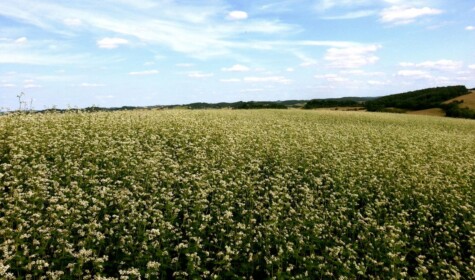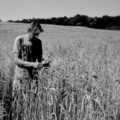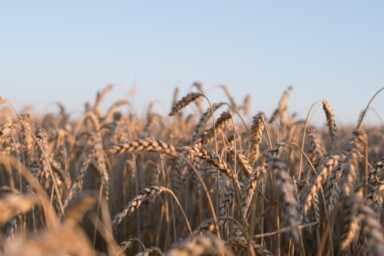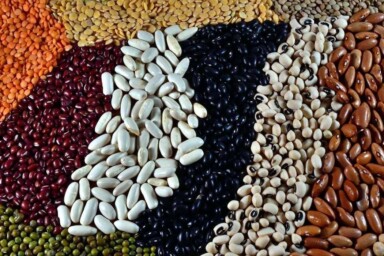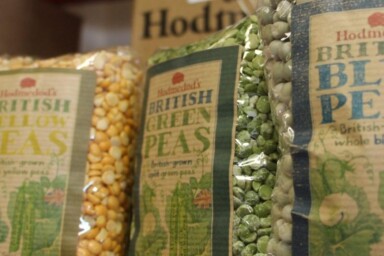Until I was 35 years old, I was a musician who was frequently on the move. A visit inside an industrial meat facility had left me a long-standing vegetarian and I had read enough newspaper articles about pesticides to buy organic vegetables when possible. But that was where my knowledge of where our food comes from ended. I’d never sown a seed or transplanted a bedding plant. One day, on my travels, I read an article about today’s oil and chemical based food production model that concluded with a line that stuck: ‘If you don’t like the system, don’t depend on it.’ Inspired by my neighbours’ veg patches in our corner of rural France, I decided to have a go at food autonomy.
The first time I walked into the greenhouse and saw the seeds that I’d planted had sprouted, it was a revelation. When they became food on our family table just a few weeks later, my life was irrevocably changed. I wondered why something as fundamental, transformational and beautiful as growing food, isn’t one of the first things we are taught at school.
What began as a hobby, growing vegetables for my family whilst repeatedly reading John Seymour’s The Complete Book Of Self Sufficiency in the hope that at least a small part of it would rub off, quickly became a passion that will occupy me for the rest of my life.
My soil and farming library expanded with the likes of Albert Howard, Masanobu Fukuoka, Edward Faulkner and F.H. King amongst many others. The core message will not be news to readers of this site – that our existence depends entirely on the few inches of the earth’s surface that we call topsoil, that we have already lost a lot of it and that the rest is in pretty bad shape. One of things that I like to share with the students who visit our farm, is that the vast array of life under our feet, still so little understood, is the only thing that can turn death into life. A collective effort of all the computers in the world could not turn a fallen tree into grass, fruit, salad, nuts or flowers. All of this remarkable and essential subterranean life requires leaves to feed it, which is why, of course, nature never leaves soil exposed. The head of our local tree planting agency always closes his soil husbandry talks with the line ‘no plants, no future’.
Our vegetable patch had been transformed with the adoption of no-dig and companion planting techniques. Gone were the days when, following my weedkiller-using neighbour’s example of long, rotovated strips of bare earth, it would sometimes take a whole day of weeding just to find the tomatoes. Faced with increasingly abundant produce, I began selling vegetables at our local market. This got off to a bad start when an elderly lady with a keen eye for the weight of leaves correctly pointed out that my scales were dodgy and broadcast this to the entire market. It was news to me that a new set of scales may require calibrating. But after clawing back my reputation of having some success with the veg and increasingly alarmed at what I saw happening to the soil in the maize producing fields around me, I decided that I wanted to join the ranks of those attempting a restorative kind of farming at scale. I sold the publishing rights to my music, and my family and I put everything we had into buying a farm in our corner of South West France.
The first few years were, in short, disastrous. Under a tsunami wave of new things to learn and understand – tractors, irrigation, silos, grain cleaners, tax systems, seed sellers and grain buyers – I lost sight of everything I had learned in the vegetable patch and the reason why we’d taken such a giant leap to buy the farm in the first place: namely, how can we grow crops in a way that nourishes people and restores soil? Neighbours and advisors talked of ‘losing control’ of the fields to weeds, and there was significant financial pressure on me not to do that. The result of all this was that I was drawn into a kind of organic farming that uses regular soil cultivations to keep the fields ‘clean’. I didn’t plough, but used discs, harrows, cultivators and inter-row hoes in quick rotation. In so doing, I learned a great deal, but it was clear that from both a financial and an environmental perspective, things just weren’t adding up. In fact, by releasing even more organic matter from our already heavily degraded soil (the farm had only 0.5% organic matter when we bought it) my cultivations were exacerbating the conditions which led to the prevalence of so many difficult weeds. I was powerless against the march of the thistle and dock.
We were close to being forced to abandon the project, to cut our losses and sell the farm. But before doing so, I kept returning to the simple truth in so many of the books I had read: the worlds’ forests and grasslands yielded their fruits every year without any chemicals or cultivation, at the same time as improving the soil. The key in all this is diversity, and, according to Albert Howard, the symbiosis between plants and animals. Howard is adamant that no sustainable system of farming has ever existed which excludes animals.
So, it was in that one last roll of the dice, someone who up to this point had never had a pet, ended up welcoming a herd of cows. At the same time, we began replanting miles of hedges, hundreds of trees and putting fields down to Newman Turner’s Herbal Lay mixtures. Elsewhere on the farm I began testing cropping techniques pioneered by the Rodale Institute, which involved rolling down cover crops with a specially designed roller in order to create a field-scale mulch through which a cash crop is sown. This proved very successful, with good crops of maize planted through vetch or soya through rye and other associated experiments such as using the allelopathic power of frost sensitive plants such as buckwheat to pave the way for winter cereals.
I had read many times that the way to deal with weeds is to create the soil conditions under which their presence is no longer required. It sounds like an impossibly optimistic idea. But it was startling to watch the disappearance of hectare after hectare of thistle and dock that followed the end of tillage and the introduction of diversity.
What was clear was that the soil in our mob grazed perennial pastures was improving at a speed that was incomparably faster than in the fields where I was experimenting with a succession of annual cover crops and cash crops. A rapid increase in organic matter is not only crucial for the retention of water as our climate changes and leads to increasingly extreme swings between rain and drought, but for the sequestration of carbon itself. Nevertheless, as a 20-year vegetarian, taking my first cow to slaughter was a moment of deep introspection. But I remain convinced that 100% pasture-fed meat from animals that sustain a myriad of life in the farm ecosystem, is a product that needs to be properly explained to consumers and differentiated from other forms of meat.
The speed of regeneration under pasture led to my interest in the idea of sowing annual grains into grass. There were precedents here. Masanobu Fukuoka, author of One Straw Revolution, grew wheat in a living mulch of white clover for decades, and I had seen a farm in California doing the same and also the experiments of Bonfils, a mysterious Frenchman tragically found dead in a railway station, but who achieved on a small scale, amazing yields from this wheat / clover combination in the 1970s. There was also Colin Seis in Australia, who was planting oats into pasture, though with the significant difference that his native grasses were dormant during the critical periods of cereal growth. What I wanted to try was the growing of cereals in diverse pasture rather than just clover, to harness the benefits of all those different plants, their different rooting depths and relationships with different soil organisms.
So much regenerative agriculture appears to be complicated by the dominance of non-competitive, chemically dependent crop varieties. Sowing into pasture would clearly require highly competitive varieties. In the field of wheat, we are lucky in that the likes of Jean-Francois Berthelot in France or John Letts or Andy Forbes in the UK, have dedicated years to saving and multiplying varieties that predate the Green Revolution and are suited to low input, competitive systems. I was also lucky enough to encounter a retired farmer-baker near my farm in France who still had a little of his family’s wheat population, which turned out to be highly competitive when sown into grass.
There were many trials and tribulations before finding the right seed drill to place seed through pasture into our heavy clay and combining this with a grazing pattern that allowed us to favour the wheat over the grass. Often the wheat would look promising at the beginning but be overwhelmed by perennials in late spring. But in time, as drilling and grazing management improved, we began to see real results, eventually reaching a point where these techniques allowed us to grow wheat for our farm mill and bakery.
As friends (now colleagues) came to the farm and saw grains being grown in this way and began to understand the effect this has on the soil, environment and nutritional quality of food, the question was asked as to how we might begin to do it at scale.
The principal problem we had with our original pasture sowing method was the very precise grazing management required (especially difficult in inclement weather and certain soil types) together with the risk of lodging (crops falling over flat before harvest). Given that the understory of pasture plants was about 30 cm high at harvest, if the wheat was knocked over, harvest became very complicated. In the case of growing for our bakery, this was not a major problem in that we could sow more than we needed and thus have room for error. But in order to adapt the system for cereal farmers operating at scale, we needed to remove this risk. It was this need to control the height of the pasture which led to the development of a whole new row cropping system.
Effectively, what we developed was a combination of strip tillage and inter-row mowing, the aim being to minimise and localise soil disturbance in narrow strips where the crop can grow quickly, densely and be given optimum care whilst allowing for control of grass height at harvest.
But this was only one part of the story. Equally crucial would be to create a supply chain which rewarded farmers for quality rather than quantity. The vast majority of my farming neighbours just want to farm, rather than deal with all the additional processes involved in direct-to-consumer sales. So to allow them to get out of a cycle where yield at any cost was the name of the game, we would need to set up our own supply chain which allowed farmers to be properly rewarded for the quality of their grain and of the ecosystem and soil in which it was grown.
These thoughts led to the creation of Wildfarmed Grain, which allows consumers to participate directly in restoration of farmland via the purchase of 100% traceable, nutritious food, grown by farmers who have adopted a chemical-free, carbon positive path. Our hope is that we can work together with enough farmers so as to get to a point where a significant percentage of the 13 million daily loaves produced in the UK are made from grains grown in flourishing, diverse ecosystems.
The natural world is a place of astonishing beauty and abundance. More than that: it’s who we are. Everything we eat, breathe, drink and buy was created by it, and when we declare war on it, we declare war on ourselves. Once we begin to live in harmony with it, we create a succession of virtuous cycles. Health, environment, wildlife, climate, water, social justice, meaningful employment, and, not least, happiness – the solutions to so many of the fundamental issues of today begin with the way we produce our food.
